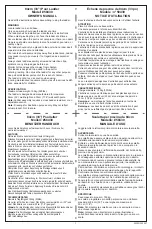
EN
19
• Unfavourable weather conditions, for
example strong wind.
• Collision between ladder and for example
door or vehicle.
• Unsuitable ladder for the purpose, for
example too short or unsuitable type.
Handling risks
• Transport of ladder to workplace.
• Putting up and taking down ladder.
• Carrying objects up and down the ladder.
Slipping and stumbling risks
• Unsuitable footwear.
• Fouled rungs.
• Ill-advised and dangerous behaviour of
user, for example climbing two rungs at
once or sliding down along side rails.
Structural risks
• The condition of the ladder, for example
damaged side rails.
• Overloading of ladder.
Electrical safety risks
• Work that must be conducted with
voltage, for example troubleshooting.
• Do not place the ladder too near live
electrical equipment, for example power
lines.
• Damage to protective casing, insulation
etc. on electrical equipment caused by the
ladder.
• Using for work with or near electrical
equipment, unsuitable type of ladder.
For further information, for example
concerning inspection of the product, contact
the manufacturer.
SAFETY INSTRUCTIONS
• Secure the product in a suitable way when
transporting it to avoid damage.
• Check after acceptance and before using
for the first time that no parts missing or
damaged. Do not use the product if it is
damaged, or if parts are missing – contact
the retailer.
• Always check before using the product
that it is undamaged and safe to use.
• Check that the product is suitable for the
actual task.
• Make sure that the product is free from
water, clay, snow, oil etc. before use.
• A risk assessment must be made in
accordance with the law in the country of
use before it is used professionally.
• Do not modify the product.
RISK OF ACCIDENTS
The list below indicates common risks of
accidents in connection with working with
ladders. The list has formed the basis for the
content in these instructions, but does not
cover all conceivable risks that can occur when
working with ladders.
Stability risks
• Incorrect positioning of the ladder, for
example the incorrect angle for a
freestanding ladder or incomplete
extension of a step ladder/folding ladder.
• Sliding of the bottom end of the ladder
(ladder sliding out from the wall).
• Sliding sideways, falling sideways or falling
over the top rung, for example as a result of
attempting to stretch too far or insufficient
bearing of the ladder’s upper support point.
• The condition of the ladder, for example
lack of non-slip feet.
• Stepping off at height from an
inadequately secured ladder.
• Ground conditions, for example soft
surface with inadequate support, or
sloping, slippery or fouled surface.
Summary of Contents for 025454
Page 3: ...1 1 2 1 2 ...
Page 44: ......













































